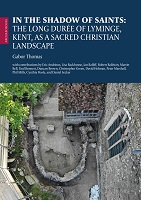In the Shadow of Saints
the Long Durée of Lyminge, Kent, as a Sacred Christian Landscape
| dc.contributor.author | Thomas, Gabor | |
| dc.date.accessioned | 2023-01-26T09:53:50Z | |
| dc.date.available | 2023-01-26T09:53:50Z | |
| dc.date.issued | 2023 | |
| dc.identifier.uri | https://library.oapen.org/handle/20.500.12657/60888 | |
| dc.description.abstract | Originating in the seventh century as one of the ‘Old Minsters’ of Kent, Lyminge has one of the longest continuous Christian histories in Britain. Drawing upon the results of two campaigns of re-investigation in the early 1990s and 2019, this paper elucidates this trajectory through a rigorous reassessment of archaeological remains in Lyminge churchyard, originally explored by the antiquary Canon Jenkins in the 1850s. This work generates fresh insights on the structural archaeology of the churchyard and Jenkins’ influence on the interpretation and public presentation of Lyminge’s early Christian heritage. New details of the seventh-century apsidal church are presented, allowing its place within ‘Kentish Group’ churches to be appraised with greater confidence, and aspects of the operational sequence of such buildings to be reconstructed for the first time. A fresh examination of structural foundations to the west of the apsidal church, and the current parish church of SS Mary and Ethelburga, charts the monumental development of the site into the Late Saxon period and beyond, offering insights into the commemorative processes bound up with the long-term evolution of the cult focus. Findings beyond the churchyard, from previous research excavations by the University of Reading, are also woven into the current study to contextualise developments within the monumental core, providing an exceptionally rare integrated ‘big picture’ perspective in the study of early medieval monastic archaeology. The results of scientific dating, and the analysis of bioarchaeological data, are applied to reconstruct the lived experience of the monastic community during the Viking Age, and to chart the complex settlement transformations during Lyminge’s afterlife as a secular minster church and seat of archiepiscopal authority. Complementing other recent work on the long-term development of monastic landscapes, this paper vividly demonstrates how the enduring mythology of the golden age of Anglo-Saxon saints influences the interpretation of sacred Christian heritage and how archaeological approaches can inform narratives of these potently meaningful places. | en_US |
| dc.language | English | en_US |
| dc.relation.ispartofseries | Archaeologia | en_US |
| dc.subject.classification | thema EDItEUR::N History and Archaeology::NK Archaeology::NKL Landscape archaeology | en_US |
| dc.subject.classification | thema EDItEUR::N History and Archaeology::NK Archaeology::NKD Archaeology by period / region | en_US |
| dc.subject.classification | thema EDItEUR::1 Place qualifiers::1D Europe | en_US |
| dc.subject.classification | thema EDItEUR::3 Time period qualifiers::3K CE period up to c 1500::3KL c 1000 CE to c 1500 | en_US |
| dc.subject.classification | thema EDItEUR::A The Arts::AM Architecture::AMN Architecture: religious buildings | en_US |
| dc.subject.other | Sacred heritage; Anglo-Saxon saints; early medieval monasticism; Anglo-Saxon churches; Anglo-Saxon Kent; early medieval settlements; Viking raiding | en_US |
| dc.title | In the Shadow of Saints | en_US |
| dc.title.alternative | the Long Durée of Lyminge, Kent, as a Sacred Christian Landscape | en_US |
| dc.type | book | |
| oapen.identifier.doi | 10.26530/20.500.12657/60888 | |
| oapen.relation.isPublishedBy | d42419c2-5275-411b-8855-aed87bed3f71 | en_US |
| oapen.imprint | First | en_US |
| oapen.series.number | 112 | en_US |
| oapen.pages | 154 | en_US |
| oapen.place.publication | London | en_US |

